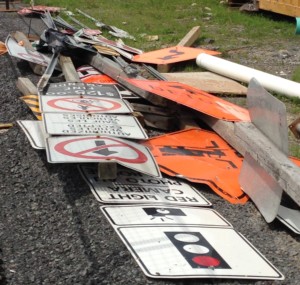Canada
Dutch minimize signage to maximize intuitive road design
The space on our roads is slowly filling up with traffic signals and traffic signs. In the Netherlands, sign overload has long been a bone of contention.
Is there such thing as too many signs? Are all these signs really necessary for a road user? Is the road design legally correct? Are there some traffic signs that are not really necessary? In wintery countries signs are often necessary as road paint can be covered by snow. But can we solve that with more intuitive design instead
 30% unnecessary signs
30% unnecessary signs
At Mobycon, we work with our clients and parters to achieve intuitive design. In our expereince at least 30% of municipal signage could be removed. Another 25% could be taken away with minor modifications to street and sidewalk design. This includes the proper execution of an exit or the reconfiguration of a bicycle advisory lane into a proper bicycle lane.
Ignoring signs
Scientific research has shown that drivers only notice 10%-20% of traffic signs. This means that the vast majority of signs carry a message that is not being noticed. Too many signs can actually reduce traffic safety when it becomes difficult for road users to differentiate really important signs from the less important ones. Therefore from a traffic safety perspective, careful selection of signage is of the upmost importance.
Advantages of less signs
Besides traffic safety, there are other advantages of showing restraint when placing signs:
- Quality of the public space
Restricting the number of traffic signs can often be combined with a rearrangment of space to allow road users to determine their behaviour using basic traffic rules. The most extreme variation of this concept is the ‘shared space’ approach. - Procurement, management and maintenance cost
Traffic signs require proper maintenance. This is especially the case in winter countries such as Canada and the northern US, as snowplows cause considerable damage throughout the winter. Purchase and placement of a sign can cost around 200 Euros in the Netherlands and it is probably no cheaper in other places. On average a sign needs to be replaced every 10 years. That doesn’t sound like much, but with the large numbers of signs, it all adds up.
“Sign shy, sign free” approach
In the Netherlands the ‘sign shy, or sign free approach’ is very common. More and more local governments are removing legally unnecessary signs and working towards a pleasant, comfortable and readable public spaces. Whether you opt for ‘sign shy’ or ‘sign free’, the result is a safer and more livable traffic space with lower management costs.
Photo by Hans Moor


 ">
">